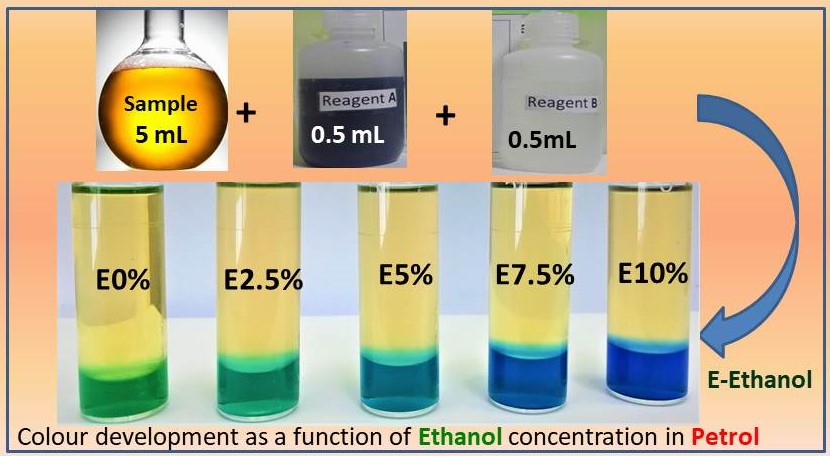

Petrol is the primary fuel for automobiles. However, it is getting replaced with ‘ethanol blended petrol’ in a phased manner. The blending with alcohol aims to reduce environmental pollution, lower the dependency on petrol and to make the fuel cheaper. Pure hydrous or anhydrous ethanol cannot be used as fuel due to technological and safety reasons. Presently, Government of India through its Ethanol Blending Programme envisages achieving 10% ethanol blending of petrol by 2022 and 20% by 2030. The determination of the content of ethanol in petrol is required for compliance with fuel specifications and regulatory purposes or to detect any adulteration. BARC has developed a visual colorimetric method to determine up to 20% ethanol in petrol. The method is simple, rapid and precise. Concentration (ethanol) dependent colour development forms the basis of this method. The two chemicals used are cheap, easily available and benign. The method does not require any instrument or formal chemical education and can be practiced by even by common public.
Petrol is getting replaced with ‘ethanol blended petrol’ as a fuel for automobiles. The blending with alcohol aims to reduce environmental pollution, lower the dependency on petrol and to make the fuel cheaper. Pure hydrous or anhydrous ethanol cannot be used as fuel due to technological and safety reasons. Presently, Government of India through its Ethanol Blending Programme envisages achieving 10% ethanol blending of petrol by 2022 and 20% by 2030. The determination of the content of ethanol in petrol is required for compliance with fuel specifications and regulatory purposes or to detect any adulteration. BARC has developed a visual colorimetric method to determine up to 10% ethanol in petrol. The method is simple, rapid and precise. Concentration (ethanol) dependent colour development forms the basis of this method. The two chemicals used are cheap, easily available and benign. The method does not require any instrument or formal chemical education and can be practiced by even by common public.
Introduction
Petrol is getting replaced with ‘ethanol blended petrol’ as a fuel for automobiles. The blending with alcohol aims to reduce environmental pollution, lower the dependency on petrol and to make the fuel cheaper. Pure hydrous or anhydrous ethanol cannot be used as fuel due to technological and safety reasons. Presently, Government of India through its Ethanol Blending Programme envisages achieving 10% ethanol blending of petrol by 2022 and 20% by 2030. The determination of the content of ethanol in petrol is required for compliance with fuel specifications and regulatory purposes or to detect any adulteration. BARC has developed a visual colorimetric method to determine up to 10% ethanol in petrol. The method is simple, rapid and precise. Concentration (ethanol) dependent colour development forms the basis of this method. The two chemicals used are cheap, easily available and benign. The method does not require any instrument or formal chemical education and can be practiced by even by common public.
The Detection kit consists of :
| Reagents | 2 bottles (100 mL) |
|---|---|
| Graduated 15 mL polypropylene test-tube | 5 Nos |
| Color Chart | 1 No. |
INFRASTRUCTURE
Statutory Requirements
Raw materials
Manpower requirements
